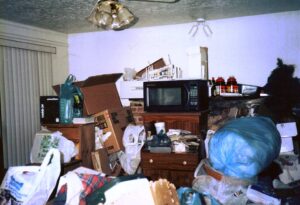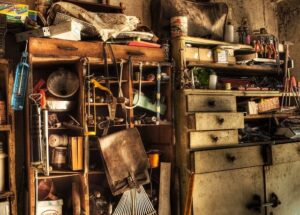Cleanup of homes where someone with a hoarding obsession lives can be a daunting task on its own, but it is even more challenging when animals are involved. Animal or pet hoarding is a specialized form of hoarding. The Mayo Clinic categorizes it as a mental health disorder when it involves accumulating an inappropriate number of animals. And the ASPCA estimates that at any point in time over 250,000 animals may be victims of hoarders. Most often it involves cats or dogs, although other common animals kept by hoarders are reptiles, rodents, and birds. Some even will hoard farm animals in a non-agricultural setting.

Just how many animals is inappropriate to keep in a home? There are many factors here, including the space available, as well as the physical and financial resources of the individual to properly care for the animals. You wouldn’t say the owner of a 500-cow dairy farm was a animal hoarder, but the elderly woman across the road with 52 cats in a two-bedroom house certainly would be.
Of course, the primary concern is the mental health care the animal hoarder needs, which should be a top priority when the removal of the animals and cleanup of the property is being considered. There should be a plan for that care before efforts begin to put the home in order. Sudden removal of animals can be very traumatic to the individual, so a mental health professional should be involved. And it is crucial that the person understands that the welfare of the animals is involved, as well as their own.
The next step is to attend to the welfare of the animals, which usually will involve the efforts of a local animal welfare agency or an animal rescue. Animals must be caught, safely contained and transported, and then evaluated medically. Sadly, often these animals do not survive because of the neglect. And often dead animals are found as the property is examined in detail.
Then begins the clean-out and decontamination of the house, which should only be undertaken by a trained biohazard remediation company, since there are a number of health and public safety issues posed.
In addition to the usual removal of trash and deep cleaning that accompanies a typical hoarder home cleanup, when animals are present there are a number of health threats. In all likelihood, the animals themselves are not healthy, because they are not being properly cared for. It’s not unusual for them to be sickly, malnourished, and ridden with fleas, mites, and other parasites. The animals may be infected with contagious diseases that could be passed to other animals, so that must be taken into account as well. Microbes from those diseases could remain behind on the property even after the animals have been removed.
Chances are their urine has soaked the flooring and other structural elements. For example, it’s common in a home that is overrun with cats to find them in attic spaces or behind walls, so insulation, ceiling tiles, and drywall are probably contaminated. Feces is a breeding ground for a number of health-threatening bacteria. And hoarders often strew food around on the floor, which means there may be rodents or maggots, or at the very least, bacteria feeding on the decomposing food scraps. Mice and other rodents themselves pose health threats that must be dealt with as well.
Personal protective gear needs to be worn by those handling the cleaning. That includes such things as goggles, respirators, hazmat suits, and disposable footwear covers and gloves. In spaces where the urine odor is exceptionally strong, respirators may be required. Animal hoarding cleanup involves several steps:
- Removal and proper disposal of all biological substances, including bodily fluids such as blood, vomit, urine, and feces. It would also include disposal of any deceased animals. Feed scraps are also considered biological materials. Carpeting, textiles, and even furniture often have to be disposed of as well, when cleaning is impractical.
- Sanitizing the property using medical-grade chemicals and appropriate processes.
- Deodorization. Animal urine produces pronounced ammonia fumes that can remain for an extended period of time if the urine has soaked permeable materials such as flooring, walls, etc.
- Other cleanup. Animal hoarders typically neglect the physical maintenance of their homes, and most likely the property will be cluttered with debris, trash, broken fixtures and furniture, etc. All that must be removed and properly disposed of.
- Restoration of the property. The final goal is restoration of the home to a livable, sanitary condition. At times this is not possible; we have encountered mobile homes where animal hoarders resided, and the homes needed to be demolished and removed because restoration was not financially or physically feasible. In situations where it is practical, structural repairs need to be made, flooring needs to be replaced, walls and ceilings need to be painted, etc. There may be elements such as wiring that were damaged by the animals that also needs repair.
Above all else, whenever an animal hoarder is involved, any cleanup and remediation efforts need to be undertaken by compassionate, trained biohazard professionals. In the Pacific Northwest, we’re the ones to call. We offer cleanup and biohazard remediation for animal and other hoarder homes as part of our services. Our main office is in Spokane, but we serve the greater Washington State and surrounding areas.
 Unfortunately, yes. And that brings up an issue for anyone who is considering assisting a compulsive hoarder with cleanup of the home. It’s more than an eyesore, more than clutter, more than piles of trash. Most likely almost every permeable surface is contaminated with some sort of contagious microorganism.
Unfortunately, yes. And that brings up an issue for anyone who is considering assisting a compulsive hoarder with cleanup of the home. It’s more than an eyesore, more than clutter, more than piles of trash. Most likely almost every permeable surface is contaminated with some sort of contagious microorganism.

 One of
One of 

